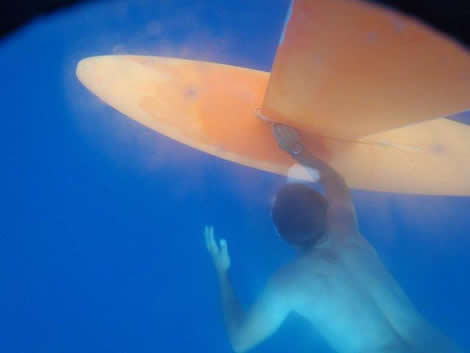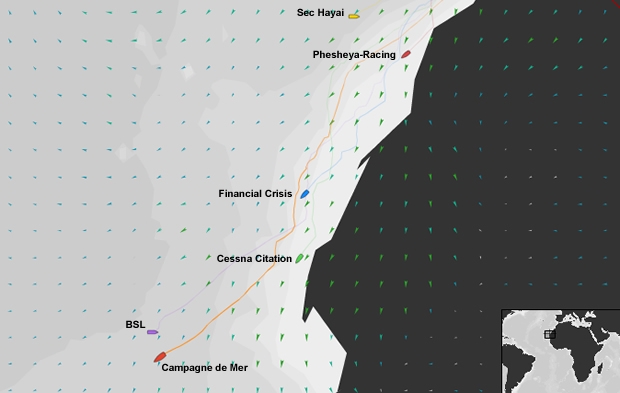Parting company with Africa
Into the evening on Monday, pockets of minimal breeze hampered many of the doublehanded Class40 Global Ocean Race fleet off the coast of Western Sahara.
Separated by 62 miles, Cessna Citation in third and Financial Crisis in fourth fell into a hole of two to four knots around 70 miles off the coast in the mid-evening before 11 knots of NNE breeze arrived before midnight, pushing the two Class40s south at seven knots.
Approximately 175 miles further north, the South African duo in sixth with Phesheya-Racing crept round Cape Juby shortly before sunset making seven knots as, 115 miles to the west, Sec. Hayai rendezvoused with a RIB off Las Palmas in the Canary Islands to collect a replacement A6 gennaker. Around 400 miles south, fleet leader Campagne de France and BSL in second place found breeze of between 12-14 knots with the separation remaining locked at 18 miles.
Throughout Tuesday, the northeasterly breeze became increasingly stable, benefiting Campagne de France and BSL first, with Cessna Citation picking up the pace at noon, followed by Financial Crisis a couple of hours later. By 15:00 GMT, Phesheya-Racing and Sec. Hayai – 430 miles north of the leading boat – were also into fresh breeze and for the first time in five days since the six Class40s left the Mediterranean and began the complex voyage along the African coast, the entire fleet was averaging over eight knots of boat speed.
By 06:00 GMT Tuesday, Ross and Campbell Field had cleared the African coast taking BSL 100 miles offshore and the threat of fishing boats and entrapment in lines and nets receeded.
Both BSL and Campagne de France continued southwest throughout Monday night and Tuesday morning in northeasterly breeze, skirting the intensely busy area of shipping around Mauritania’s main port, Nouâdhibo; a notorious graveyard of rotting hulks, cannibalised ships and a staging post for international fishing vessels.
Although the dramas of the previous night with many hours and a lot of sleep lost while tangled in a fishing net were over, the conditions on Campagne de France were still demanding: “It has been a total blackout overnight,” reported Halvard Mabire on Tuesday. “For the past few days the sky has been completely overcast and when the small crescent of moon sets during the second half of the night, that’s it. You can’t see anything.”
In these conditions, the duo wear LED head torches on a red-light setting to preserve night vision. “The only problem with red light is it distorts colour perception and things get complicated,” he explains. “If you’re going to pull or ease a red rope, for example, it’s better to think carefully of the rope’s purpose and location, rather than relying on the colour.”
Mabire and Merron built and fitted-out Campagne de France over the course of a year and are very familiar with the layout: “Fortunately, we’ve got a pretty firm idea of where everything is and don’t have to waste too much time double-checking any actions,” adds Mabire.
However, hand-steering in the pitch dark without any star or moon for reference requires an hypnotic focus on the soft glow of the cockpit instruments: “Driving in these conditions requires superhuman levels of concentration,” confirms Mabire. “So, as long as the sea isn’t too lumpy or confused, we hand the helm over to Nestor,” he explains, referring to the boat’s NKE pilots, named after Captain Haddock’s manservant in the Tintin adventures of the Belgian author, Hergé. “Nestor’s electronic eyes are unaffected by the blackout and he reacts to the information coming from the masthead wind instruments before the data is even displayed on the cockpit readouts.” Intriguingly, Class40 Campagne de France is registered as Unicorn, the 17th century galleon of the fictional captain’s swashbuckling ancestor, Sir Francis Haddock….
Throughout Tuesday morning and into the afternoon, the northeasterly breeze stabilised for the entire fleet with the two lead boats changing up a gear to just below ten knots shortly before dawn and keeping this pace through until midday, when it was the turn of Conrad Colman and Hugo Ramon to up the pace on Cessna Citation in third place, 180 miles behind the leading Class40: “Hugo and I are hand steering almost constantly and regularly changing between the big spinnaker, big gennaker and Code 0 as the wind continues to oscillate wildly,” reported Colman late on Monday.
While the majority of the GOR fleet kept consistently close to the African coast, the event’s youngest team remained further offshore on Monday skirting a wind hole, moving inshore on Tuesday morning: “Some lucky fisherman must have thought he snagged a big one when we came through as we had a huge hook and metal tracer buried in our keel but with no buoy or fishing boat to be seen,” says the 27 year-old Kiwi. “The hook caught us, but it wasn’t until we slowed to a stop yesterday that Hugo, in a fit of cleanliness, dived over to get it as part of his showering procedure.”

Prior to Cessna Citation picking up speed, Colman’s mind wandered: “With so much quiet time at the helm I have had time to think about what it must have been like for my late father when he set of from the East Coast of the States in his own bid to sail around the world in the Seventies and about the nature of our sport and how it has become just that, a sport, rather than an adventure into the unknown,” muses Colman. “It must be remembered that the first non-stop race around the world was only in 1969, and was won by a bearded Englishman brandishing a rifle and on a boat carved in India out of teak! In the intervening years, a racing circumnavigation has gone from an unrivalled curiosity of human endeavour to a horse race measured in minutes and seconds. That said, the oceans that lay before us are still as wild as savage as they always have been.” At 15:00 GMT on Tuesday, Colman and Ramon were on port gybe making 10 knots in around 15-17 knots of north-easterly breeze heading into the coast north of the busy shipping area at Nouâdhibo.
While Colman contemplated the nature and history of round-the-world racing, Marco Nannini and Paul Peggs bit into the stronger breeze with Financial Crisis, keeping the distance to Cessna Citation at 60 miles.
Meanwhile, Nick Leggatt and Phillippa Hutton-Squire with Phesheya-Racing were gybing south along the coast in a narrow band of breeze and were beginning to pick up speed as they sailed very close inshore to Cape Boujdor in the mid-afternoon. Sailing further west and closer to the rhumb line to the Fastnet Marine Scoring Gate off Brazil, Nico Budel and Ruud van Rijsewijk on Sec. Hayai were three miles ahead of the South Africans having struggled in light airs off Gran Canaria overnight following the rendezvous to collect a replacement gennaker.










Latest Comments
Add a comment - Members log in